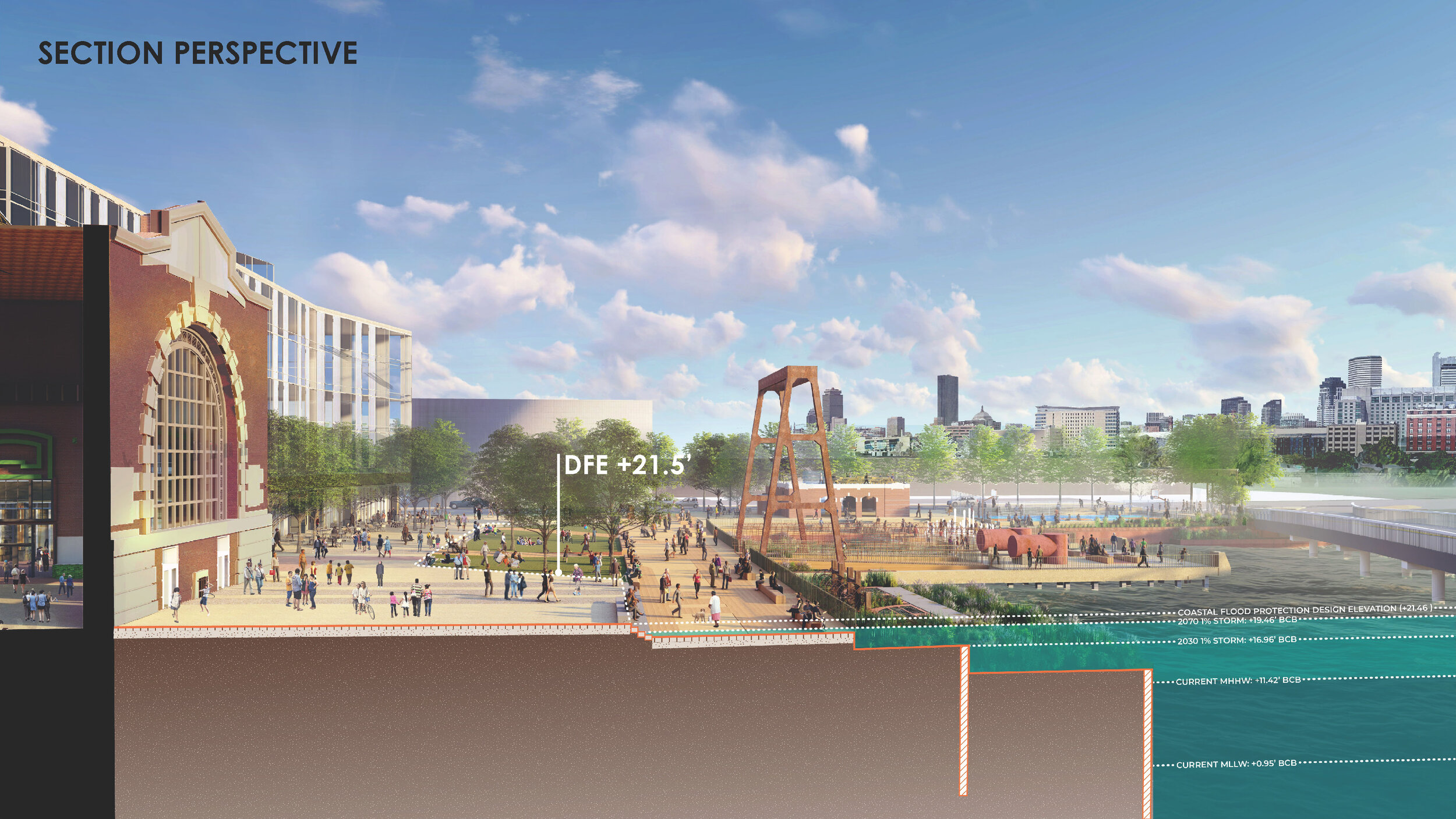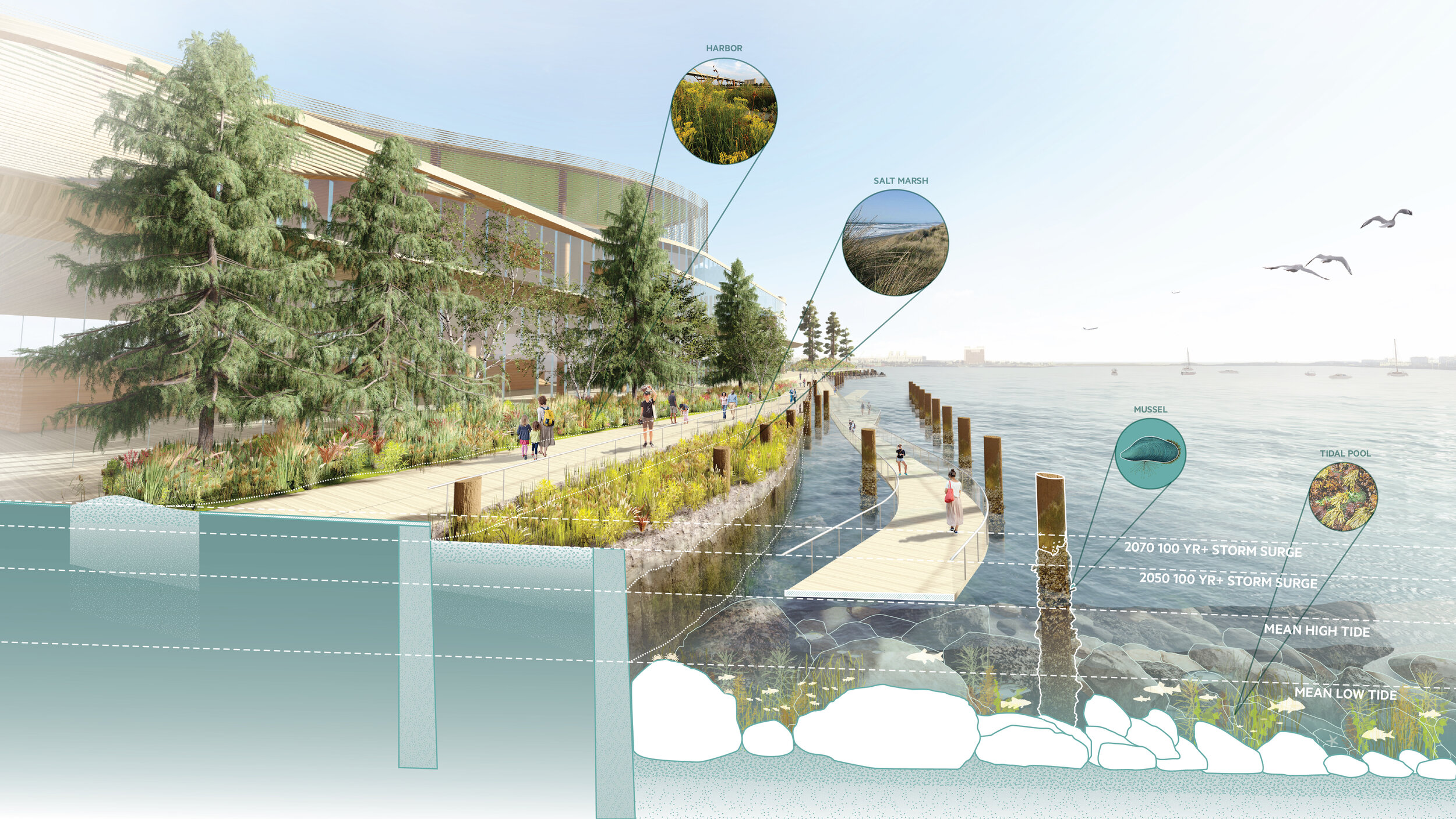CLIMATE ADAPTATION + RESILIENCY
At Stoss we approach designing for resiliency with an optimistic mindset, taking on technical issues of risk reduction and going beyond them, to create beautiful and engaging spaces that protect, energize, educate, and generate new experiences.
Whether inventively incorporating stormwater management into sites, constructing waterfront projects in regions prone to flooding, advocating for equitable urban canopy, or addressing the unique challenges that arid climates pose, our team begins with the foundational belief that infrastructure should be multi-functional—that investments in climate resilience should provide multiple social, environmental and economic benefits.
With sea level rise, intensified storms, increasing heat and more frequent flooding, it is critical that municipalities, non-profits, private landowners and citizens work together to create a toolkit of design and policy measures that responds to an increasingly unpredictable climate. This includes scaling up green infrastructure and nature-based solutions. Streets, open spaces, buildings and infrastructure can be designed to direct, collect and absorb water while providing equitable social and economic opportunities.
Stoss has long built green infrastructure into our projects, working with clients to capture and, where possible, treat runoff on site. We integrate blue-green infrastructure into our resiliency solutions in a wide variety of ways. Sometimes the sustainability measures we design are explicit, as with the lowland marsh that collects stormwater and creates new space for river flooding in Erie Street Plaza; here sustainability is made visible and produces a beautiful space that might not otherwise be possible.
Other times, they are more subtle and implicit, as with the permeable paving and infiltration zones tucked under the benches at the CityDeck in Green Bay. Often though, we try to create special experiences that bring resilient solutions to life for people. Within Gerstacker Grove, a campus quad at the University of Michigan, we designed lush, shady stormwater gardens with interactive lighting features that flicker in response to stormwater entering the garden—creating and amplifying a unique experience.
We are also interested in ways that resilience strategies can become educational opportunities. How can we tune and amplify environmental cycles, through technology, play and art? How can we educate people (especially children) on climate change and resiliency measures? To these ends, we think creatively about social interactions within the spaces we create and how resilience measures can foster new ones.
Water Conservation
In arid environments, water scarcity coupled with extreme climatic conditions compels us to design with key factors in mind; native planting, water use, materiality, shelter and the ability for the site to withstand sudden shifts in weather. Again, we utilize blue-green infrastructure to flexibly respond to both stormwater inundation and long-standing droughts. At Venice High School in Los Angeles, we preserved existing trees on campus while adding adapted and native species to the canopy to reduce urban heat island effect. In addition, most stormwater is captured within the landscape for bio-filtration and treatment. The design allows stormwater to be a feature in the landscape with hardscaped runnels acting as conveyance outlets to adjacent bio-swales which lead to rain gardens dispersed across campus. Tree species were selected with the intention to enrich the learning potential of the campus as an interpretive landscape—supporting a contemporary view of environmental stewardship.
Coastal Flooding
Our experience working extensively on the Boston harborfront, for both the City of Boston and private developers, has informed much of our practice on coastal resiliency. The partnerships we have honed on projects such as; Climate Resilience Solutions for East Boston/Charlestown and Downtown Boston; Moakley Park; Suffolk Downs; and L Street Power Plant have resulted in innovative design solutions in conjunction with top resiliency-focused engineering teams and coastal, ecological, and oceanographic consulting firms. In this context, we employ a layered combination of blue, green and gray infrastructure that withstands impacts and adapts accordingly. Together these are adapted to the unique conditions and our clients’ level of acceptable risks. For example, to thread flood protection infrastructure through a dense urban environment, we might propose an approach that includes landscapes that allow for flooding in certain areas while consolidating structural protections that keep the water out in others.
Our approach to gray infrastructure recognizes that, where structural systems are necessary for resilience strategies to be effective, they need to be integrated with aesthetic character and broader landscape improvements, or be tucked away out of sight during non-flooding conditions. Our team includes engineering and urban planning specialists that have successfully designed “hidden” flood protection structures, including passively or actively deployed flood walls, piers and coastal structures, underground stormwater and sewer infrastructure, and other systems that are integrated into the urban environment.
Urban Canopy
Increasingly we are working with cities, arborists, researchers and specialists in anti-racism policies and practices to assess tree equity and create urban forest master plans. Increased tree canopy in urban areas is a critical step in our ability to adapt to a changing climate. Trees act as critical infrastructure for our communities; they reduce air temperature, shade surfaces, reduce energy usage in buildings–overall they offer a significant means to reduce the impacts of climate change, helping to offset the urban contribution to it. In addition, they have social benefits such as mental and physical health and they help to create communities that people want to live in and engage with their neighbors outside.
Racist practices such as redlining and urban renewal, in addition to uneven development patterns have left many neighborhoods with significantly less canopy than their whiter, wealthier neighbors. We believe that all residents of our cities should enjoy the many benefits of trees. For this reason, in Los Angeles our team has joined with City Plants, LA’s first urban forester, and researcher Vivek Shandas, to establish an ‘Urban Forest Equity Collaborative’. Together we’ve completed an assessment of LA’s tree equity and are developing solutions to mitigate the extreme lack of equity in the distribution of LA’s trees. And in Boston, we are working to create Boston’s first Urban Forest Master Plan, one that aims to center equity in the new policies and practices around tree planting and management.
LOS ANGELES URBAN FOREST EQUITY COLLABORATIVE
Designing for our future climate means building resilient landscapes and landscape systems that can adapt and change over time. We are continually learning through this process, making us and our practice increasingly adaptive and resilient along the way. We draw, we test, and we implement. With each step we hope to create a world ever more able to adapt to the challenges we know we have to face in the future, and even those we can’t yet anticipate.








